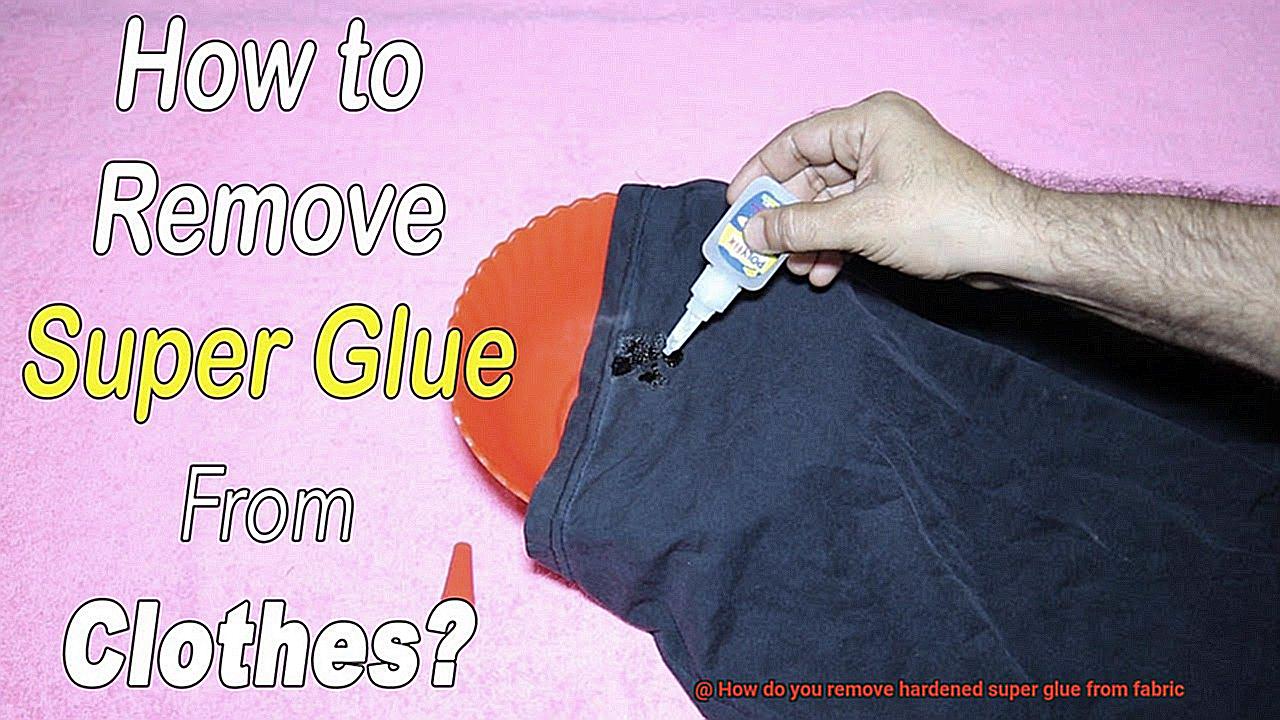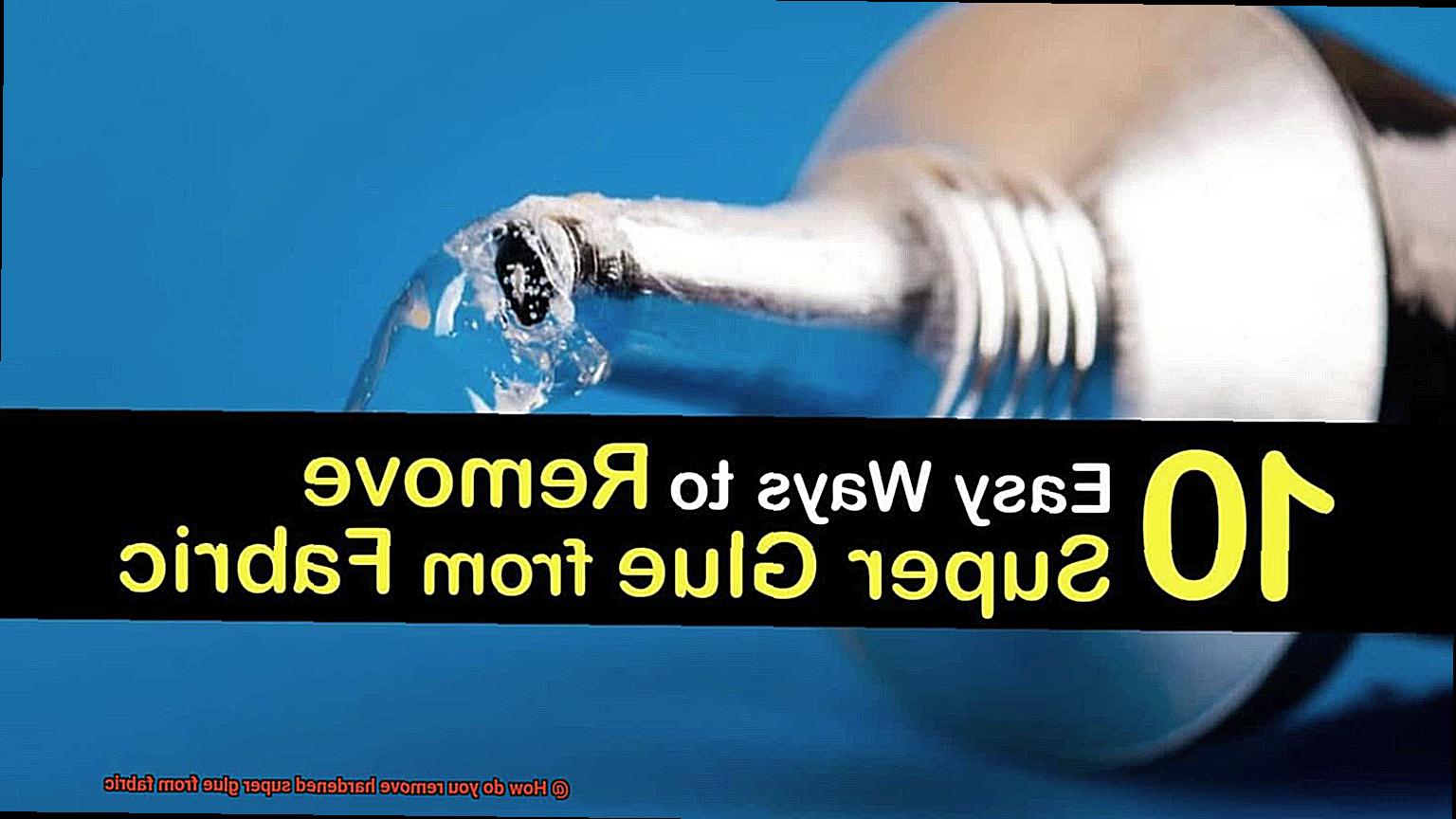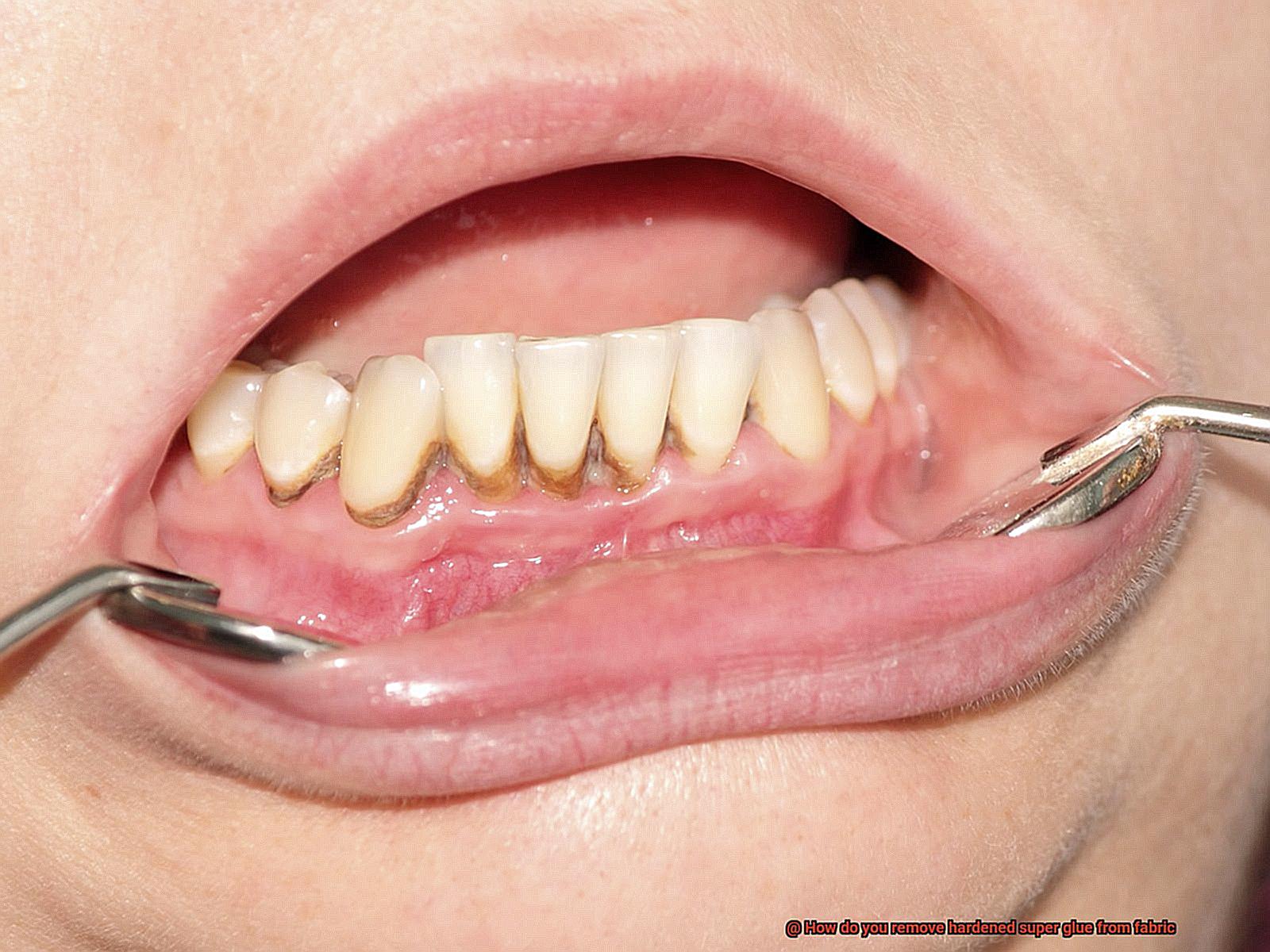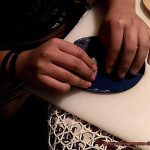Ever found yourself in a sticky situation, where your beloved fabric was unintentionally glued together? Whether it was a craft project gone wrong or an accidental spill, removing hardened super glue from fabric is a tough nut to crack. But fret not, my friends, for we’ve got the ultimate guide to liberate your fabric from its adhesive prison.
In this blog post, we’ll delve into the art of banishing hardened super glue from all types of fabrics – delicate silk to sturdy denim. We understand the frustration that comes with seeing your cherished item fall victim to an adhesive mishap. That’s why we’re here to share some invaluable tips and tricks to salvage your treasured clothing, upholstery, or any other fabric that’s battling super glue foes.
Today, we’ll explore the wonders of solvents like acetone, rubbing alcohol, and nail polish remover – watch as they work their magic on stubborn glue stains. And don’t worry if you have sensitive fabrics; we’ve got gentle approaches up our sleeves too. Prepare to be amazed by hot water or freezing methods that might just do the trick.
Join us on this daring fabric rescue mission and bid farewell to those unwanted glue marks. From understanding different fabric characteristics to selecting the right tools for the job – we’ve got you covered every step of the way. Get ready to tackle stubborn super glue stains with finesse as we embark on this sticky journey together.
So grab your reading glasses and brace yourselves for unraveling the secrets of conquering those pesky fabric conundrums. Let’s wave goodbye to adhesive woes and restore our fabrics to their former glory.
What is Super Glue?
Contents
- 1 What is Super Glue?
- 2 What are the Different Types of Fabrics?
- 3 Why is it Important to Approach Stains with Caution?
- 4 How to Remove Hardened Super Glue Using Acetone or Nail Polish Remover
- 5 How to Remove Hardened Super Glue Using Rubbing Alcohol
- 6 How to Remove Hardened Super Glue Using Warm Soapy Water
- 7 How to Remove Hardened Super Glue Using the Freezing Method
- 8 How to Remove Hardened Super Glue Using Commercial Adhesive Removers
- 8.1 The Mighty Acetone or Nail Polish Remover:
- 8.2 The Reliable Rubbing Alcohol Trick:
- 8.3 The Warm Soapy Water Savior:
- 8.4 Immerse a clean cloth or sponge in the soapy solution and delicately dab it onto the super glue stain. Allow it to rest for a few minutes, letting the soap soften the glue. Employ a soft-bristled brush or your fingers to gently massage the stain in circular motions. Thoroughly rinse with water and wash your fabric as you normally would. Voila. Glue-free fabric is within reach.
- 8.5 The Freeze and Scrape Technique:
- 8.6 For larger or thicker layers of hardened super glue, the freezing method becomes your secret weapon. Place the fabric in a plastic bag, ensuring that the glue stain faces upward. Seal the bag and stow it in the freezer for a few hours or overnight.
- 9 Conclusion
Super glue, also known as cyanoacrylate adhesive, is an extraordinary adhesive that bonds objects together with lightning speed. Derived from ethyl cyanoacrylate, a liquid monomer, super glue undergoes a rapid polymerization when it encounters moisture in the air, resulting in a rock-solid bond. It boasts a low viscosity that allows it to seep into even the tiniest cracks and gaps, making it perfect for joining materials like metal, plastic, ceramic, wood, and fabric. Once applied, super glue sets within seconds, ensuring immediate usability or further manipulation.
But what makes super glue truly remarkable is its versatility. It comes in various formulations tailored to specific needs. There are general-purpose super glues as well as specialized ones designed for bonding porous materials like fabric. These specialized formulations contain additives that enable the adhesive to deeply penetrate fabric fibers, creating an unbreakable bond.
While super glue offers unparalleled strength and convenience, it does present a challenge when it comes to removing hardened residue from fabric. The powerful bond it creates can make detachment difficult without causing damage. However, fear not. We have compiled some tried and tested methods to safely and effectively remove super glue from fabric.
One reliable method involves using acetone or nail polish remover. Before attempting this technique, it is crucial to test the fabric’s reaction to acetone on a small, inconspicuous area. If deemed safe, apply a small amount of acetone to a clean cloth and gently dab the super glue stain. Avoid excessive rubbing to prevent fabric damage. Gradually continue dabbing until the glue starts to loosen and lift off. Rinse the fabric with water and launder as usual to complete the process.
Another effective option is utilizing rubbing alcohol. Moisten a clean cloth or cotton ball with rubbing alcohol and gently blot the stain. Just like with acetone, refrain from aggressive rubbing to avoid harming the fabric. Repeat this process until the glue loosens and can be removed. Rinse the area with water and launder as usual to achieve spotless fabric.
What are the Different Types of Fabrics?
Fabrics are the unsung heroes of the textile realm, possessing the extraordinary ability to transform our everyday lives. From the comforting embrace of cotton to the regal allure of silk, fabrics have the power to elevate our clothing and home decor to new heights. Join me on this exhilarating journey as we delve into the diverse world of fabrics and uncover their remarkable qualities.
Natural Fabrics: Nature’s Embrace
Natural fabrics are nature’s gift to us, boasting an array of remarkable properties. Cotton, like a gentle breeze, caresses our skin with its breathability and durability, making it an ideal choice for clothing and bedding. Silk, with its mesmerizing sheen and luxurious feel, exudes elegance and opulence, perfect for high-end fashion and accessories. Wool, like a cozy embrace, provides exceptional warmth and insulation, making it a beloved material for winter wear and upholstery. And linen, with its crisp texture and lightweight nature, offers unparalleled freshness and comfort during summer months.
Synthetic Fabrics: The Artistry of Science
Synthetic fabrics are the avant-garde innovators in the fabric universe, pushing boundaries with their cutting-edge qualities. Polyester, a resilient fiber resistant to wrinkles and shrinking, showcases durability and shape retention in clothing, upholstery, and outdoor fabrics. Nylon, renowned for its strength and elasticity, lends itself to the creation of stockings, swimwear, and activewear that effortlessly contour to our bodies. Acrylic, an exceptional wool substitute, embraces us with its softness and warmth in knitwear and blankets that rival their natural counterparts. And rayon, a semi-synthetic marvel derived from cellulose fibers, drapes gracefully with its silky appearance, making it a go-to choice for dresses and draperies.
Blended Fabrics: The Fusion of Excellence
Blended fabrics seamlessly blend the finest qualities of multiple fibers, resulting in extraordinary combinations. Cotton-polyester blends combine the comfort of cotton with the durability and wrinkle-resistance of polyester, making them ideal for everyday wear that withstands the test of time. Wool-synthetic blends strike a delicate balance between warmth and weight, providing cozy insulation without feeling overly heavy or bulky.
Why is it Important to Approach Stains with Caution?
In this exciting journey, we’ll explore the importance of approaching stains with caution. From preserving fabric beauty to safeguarding cherished memories, taking a mindful approach can save us from potential headaches and maintain the integrity of our fabrics. So, grab a cup of tea and join me as we delve into the reasons behind this crucial practice.
Preventing damage to the fabric:
Fabrics are unique and require specific cleaning methods. Harsh chemicals or abrasive techniques can wreak havoc, weakening fibers or causing unsightly discoloration. By approaching stains with caution, we choose the right cleaning method for each fabric, preventing irreversible damage.
Avoiding color fading or bleeding:
Imagine diligently attacking a stain, only to find that it leads to color fading or bleeding. Certain stains, especially those caused by dyes or pigments, can react unpredictably to cleaning agents, resulting in patchy or discolored areas. A cautious approach minimizes these mishaps, keeping fabrics vibrant and true to their original colors.
Maintaining the integrity of delicate fabrics:
Silk, lace, chiffon – delicate fabrics deserve special attention during stain removal. Rough treatment or harsh chemicals can damage them beyond repair. By handling them gently and using specialized techniques, we ensure these treasures remain in pristine condition for years to come.
Protecting against potential allergens:

Stains can harbor more than just unsightly marks; they can be home to allergens like dust mites, pet dander, or pollen. Considering these potential triggers is vital when tackling a stain. A cautious approach safeguards us and our loved ones from allergy-induced discomfort.
Preserving sentimental value:
We all have that one special garment or heirloom piece that holds immense sentimental value. Whether it’s your grandmother’s wedding dress or your child’s first onesie, these items are irreplaceable. By approaching stains with caution, we increase the chances of successful removal without compromising their sentimental significance.
How to Remove Hardened Super Glue Using Acetone or Nail Polish Remover
Oh no. Did you accidentally get super glue on your favorite shirt or pair of jeans? Don’t worry, we’ve got you covered. In this guide, we’ll show you how to banish those stubborn super glue stains from fabric using the power of acetone or nail polish remover. Get ready to say goodbye to those unsightly stains and hello to clean, glue-free clothing.
Safety First: Check Your Fabric
Before embarking on the removal process, it’s crucial to ensure that your fabric can handle acetone or nail polish remover. Begin by testing a small, inconspicuous area of the fabric to make sure it won’t get damaged or discolored. Once you’ve got the green light, gather your materials: acetone or nail polish remover, a clean cloth, warm water, mild detergent, and a soft-bristled brush.
Dab Away with Acetone or Nail Polish Remover
Take a clean cloth and moisten it with acetone or nail polish remover. Gently dab the cloth onto the hardened super glue stain. Remember, no aggressive rubbing. We don’t want to spread the glue further into the fabric. Give the acetone or nail polish remover a few minutes to penetrate the glue and weaken its bond with the fabric.
Scrub It Off
Now it’s time to tackle that stubborn glue. Grab a soft-bristled brush or sponge and begin softly scrubbing the affected area in circular motions. This technique will lift the softened super glue from the fabric fibers. Keep at it until you see that pesky glue starting to vanish. Don’t fret if it takes a few attempts; patience is key.
Rinse Away Residue
Congratulations on removing the super glue. To ensure the fabric is squeaky clean, rinse it under warm water to wash away any remaining acetone or nail polish remover residue. This step guarantees that your fabric is free from any chemical remnants.
Wash and Wear
With the super glue gone, it’s time to give your fabric a proper wash. Use mild detergent and warm water to launder the fabric as you normally would. This final step will eliminate any lingering scent or residue from the removal process.
How to Remove Hardened Super Glue Using Rubbing Alcohol
Accidentally spilling super glue on your favorite fabric can be a nightmare. But fear not, because I have a solution for you. With the help of rubbing alcohol, you can effectively remove hardened super glue stains from fabric. In this article, we will delve into the step-by-step process of using rubbing alcohol to tackle those stubborn stains. Get ready to save your fabric and bid farewell to unsightly glue marks.
Gather Your Supplies:
Before diving into the removal process, ensure you have all the necessary supplies on hand. Grab a bottle of rubbing alcohol, a clean cloth or cotton ball, a plastic scraper or spoon, and some water. Also, take a moment to check the fabric care label for any specific instructions or restrictions.
Test on an Inconspicuous Area:
To avoid any unwanted damage or discoloration, it’s crucial to conduct a patch test with the rubbing alcohol. Apply a small amount on an inconspicuous area of the fabric and observe for adverse effects. If all is well, proceed confidently.
Apply Rubbing Alcohol:
Dampen a clean cloth or cotton ball with rubbing alcohol and gently dab it onto the hardened super glue stain. Use gentle motions to avoid harming the delicate fabric fibers. Let the rubbing alcohol sit on the glue for a few minutes to soften it, making it easier to remove.
Gently Lift the Glue:

Take a fresh cloth and gently blot and lift the softened glue from the fabric. It may require multiple attempts to fully eliminate the glue, so exercise patience and persistence. Remember to steer clear of sharp objects that could potentially damage the fabric; instead, opt for a plastic scraper or spoon to carefully scrape away any loosened glue.
Rinse and Dry:
Once you have successfully removed most of the super glue, rinse the fabric with water to eliminate any residue from the rubbing alcohol. Thoroughly rinse the fabric to prevent any potential damage caused by the alcohol. After rinsing, softly pat dry the fabric with a clean cloth or towel. Allow it to air dry completely before using or storing it.
How to Remove Hardened Super Glue Using Warm Soapy Water
Accidentally getting super glue on your favorite shirt or pants can be a real nightmare. But fear not. There’s a simple solution that won’t leave you in stitches. Using warm soapy water can effectively remove hardened super glue from fabric without causing any damage. Let’s dive into the step-by-step process and bid farewell to those unwanted glue stains:
First things first, gather all the necessary materials: warm water, mild dish soap, a clean cloth or sponge, and a butter knife or scraping tool (if needed). With everything at your fingertips, you’re ready to get started.
To begin, moisten the affected area with warm water. This initial step softens the glue, making it easier to remove. Once the area is damp, apply a few drops of mild dish soap directly onto the glue stain. Gently work the soap into the fabric using circular motions. Remember, patience is key – there’s no need to rush and risk damaging the fabric.
Allow the soapy water to work its magic for a few minutes. During this time, the soap breaks down the adhesive properties of the super glue, making it easier to tackle. After the waiting period, take a clean cloth or sponge and gently scrub the stained area. Be careful not to scrub too vigorously, as delicate fabrics require a gentle touch.
If the stubborn super glue is still clinging onto your fabric, don’t despair. You can employ a butter knife or scraping tool to carefully scrape away any remaining residue. However, exercise caution to avoid tearing or causing any damage to the fabric while doing so.
Now it’s time for rinsing. Thoroughly rinse the fabric with warm water to ensure all soap residue is removed. For any excess glue or soap that remains, use a damp cloth to wipe it away. A thorough rinse ensures that no residue is left behind, leaving your fabric clean and glue-free.
After the rinse, it’s crucial to allow the fabric to air dry completely before using or storing it. Avoid using heat to speed up the drying process, as this can set any remaining glue and make it more challenging to remove.
Remember, warm soapy water is generally safe for most fabrics. However, it’s always wise to conduct a patch test on a small, inconspicuous area first to ensure that no damage or discoloration occurs.
How to Remove Hardened Super Glue Using the Freezing Method
We’ve all been there: a little mishap with super glue leaves us with a sticky mess on our favorite fabric. There’s a super cool solution to this problem
Preparing for Success:
Before we freeze away that stubborn glue, let’s gather our supplies. You’ll need a trusty plastic bag, some ice cubes, and a trusty spoon or butter knife. Make sure the plastic bag is spacious enough to accommodate your cherished fabric without any folding or creasing – we want to treat it with the utmost care.
Bag It Up:
It’s time to give that hardened super glue the cold shoulder. Place the fabric with the stubborn glue stain facing up in the plastic bag. Seal it tightly to create a frosty fortress against any air infiltration.
Into the Freezer:
Now, let’s send that glue on an icy adventure. Place the bag in the freezer and let it chill for at least two hours, or until the glue hardens even more. We’re harnessing the extreme cold temperature to turn that super glue into fragile frost.
Liberation Time:
The time has come to free your fabric from its frozen confinement. With great care, remove the bag from the freezer and delicately extract your fabric. Be gentle as you handle it, ensuring no tears or damage occur.
Scrape Away:
Equipped with your trusty spoon or butter knife, delicately scrape away as much of the frozen glue as possible. Take your time and approach this task with patience – slow and steady wins this chilly race.
Repeat if Needed:
If the glue is putting up a frosty fight and there are still remnants clinging on, don’t lose hope. Simply return the fabric to the freezer for a longer period of time and let the cold work its magic once again.
Cleanse and Refresh:
Congratulations. You’ve conquered that hardened super glue. Now it’s time to bring your fabric back to its pristine state. Follow the care instructions for your fabric and give it a good wash. This will eliminate any lingering residue or odors, leaving your fabric refreshed and ready for its next adventure.
How to Remove Hardened Super Glue Using Commercial Adhesive Removers
We’ve all experienced the frustration of accidental super glue stains on our beloved fabrics. But fret not, for there’s a remedy. In this article, we’ll explore the wonders of commercial adhesive removers and their ability to banish stubborn super glue stains from fabric. Bid farewell to worry and welcome clean, glue-free garments.
The Mighty Acetone or Nail Polish Remover:
When it comes to removing hardened super glue from fabric, acetone or nail polish remover is often the go-to choice. However, tread cautiously and first check if your fabric can withstand acetone. Test a small, inconspicuous area of the fabric to ensure its safety.
If it passes the test, take a pristine cloth and apply a modest amount of acetone or nail polish remover. Gently dab the stain, refraining from vigorous rubbing that could embed the glue further. Witness the magic unfold as the glue gradually loosens its grip on the fabric. Rinse the area with water and launder your fabric with confidence.
The Reliable Rubbing Alcohol Trick:
Rubbing alcohol is another superhero in battling hardened super glue on fabric. Imbue a clean cloth or cotton ball with rubbing alcohol and gently blot the stain without aggressive rubbing that might harm your fabric. Repeat this process until the glue relinquishes its hold.
Once triumphant in removing the glue, rinse the area with water and toss your fabric into the washing machine. Bid adieu to glue stains and say hello to pristine fabric.
The Warm Soapy Water Savior:
For delicate fabrics that cannot endure potent solvents like acetone or rubbing alcohol, warm soapy water comes to the rescue. Mix a few drops of mild dish soap or laundry detergent with warm water.
Immerse a clean cloth or sponge in the soapy solution and delicately dab it onto the super glue stain. Allow it to rest for a few minutes, letting the soap soften the glue. Employ a soft-bristled brush or your fingers to gently massage the stain in circular motions. Thoroughly rinse with water and wash your fabric as you normally would. Voila. Glue-free fabric is within reach.
The Freeze and Scrape Technique:
For larger or thicker layers of hardened super glue, the freezing method becomes your secret weapon. Place the fabric in a plastic bag, ensuring that the glue stain faces upward. Seal the bag and stow it in the freezer for a few hours or overnight.
Once frozen, carefully scrape off as much glue as possible using a blunt knife or spoon. Exercise caution to avoid damaging the fabric during this process. Subsequently, treat any remaining residue with one of the aforementioned methods and revel in the renewed glory of your fabric.
csMvzaNGbzs” >
Conclusion
Removing hardened super glue from fabric can be a daunting task, but fear not.
With the right techniques and a little patience, you can restore your fabric to its former glory. One method is to use acetone or nail polish remover, which acts as a powerful solvent to break down the glue.
Gently dab the affected area with a cotton ball soaked in acetone, being careful not to rub too vigorously and damage the fabric. Another option is using rubbing alcohol, which can also dissolve super glue effectively.
Apply it directly onto the stain and let it sit for a few minutes before gently blotting it away with a clean cloth. If these methods don’t work, don’t fret.
There are still other options available. For example, you can try freezing the fabric by placing it in a plastic bag and placing it in the freezer for a couple of hours.
Remember to always test any cleaning solution on an inconspicuous area of the fabric first to avoid any potential damage or discoloration.






